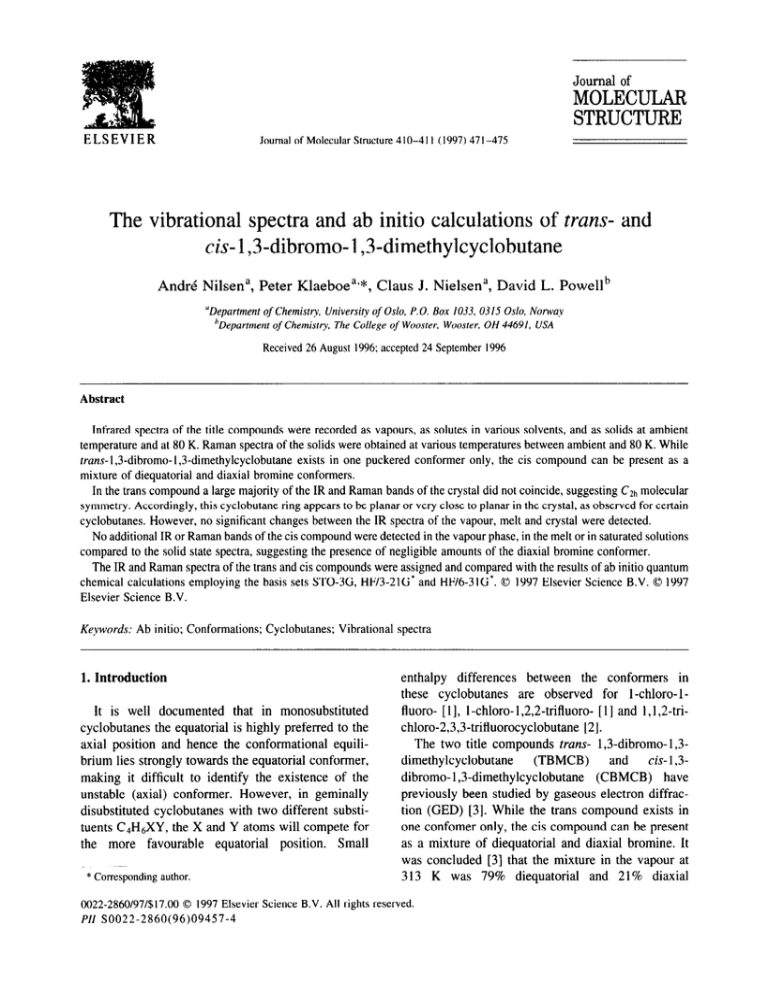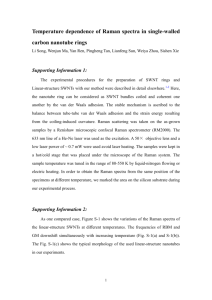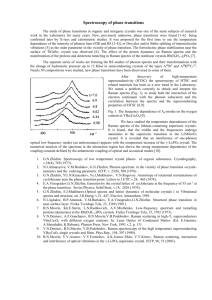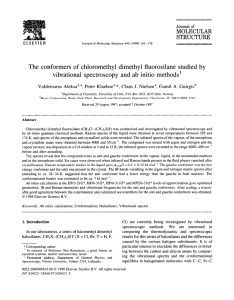MOLECULAR STRUCTURE The vibrational spectra and ab ... and
advertisement

Journal of MOLECULAR STRUCTURE Journal of Molecular Structure 41 O-41 I (1997) 47 I-475 The vibrational spectra and ab initio calculations of tram- and cis- 1,3-dibromo- 1,3-dimethylcyclobutane Andrk Nilsena, Peter Klaeboea’*, Claus J. Nielsena, David L. Powellb “Department of Chemistry, University of Oslo, P.O. Box 1033, 03I5 Oslo, Norway hDepartment of Chemistty, The College of Wooster, Wooster, OH 44691, USA Received 26 August 1996; accepted 24 September 1996 Abstract Infrared spectra of the title compounds were recorded as vapours, as solutes in various solvents, and as solids at ambient temperature and at 80 K. Raman spectra of the solids were obtained at various temperatures between ambient and 80 K. While rrans-1,3-dibromo-l,3-dimethylcyclobutane exists in one puckered conformer only, the cis compound can be present as a mixture of diequatorial and diaxial bromine conformers. In the trans compound a large majority of the IR and Raman bands of the crystal did not coincide, suggesting CZh molecular symmetry. Accordingly, this cyclobutane ring appears to be planar or very close to planar in the crystal, as observed for certain cyclobutanes. However, no significant changes between the IR spectra of the vapour, melt and crystal were detected. No additional IR or Raman bands of the cis compound were detected in the vapour phase, in the melt or in saturated solutions compared to the solid state spectra, suggesting the presence of negligible amounts of the diaxial bromine conformer. The IR and Raman spectra of the trans and cis compounds were assigned and compared with the results of ab initio quantum chemical calculations employing the basis sets STO-3G, HF/3-21G* and HF/6-3lG’. 0 1997 Elsevier Science B.V. 0 1997 Elsevier Science B.V. Keywords: Ab initio; Conformations; Cyclobutanes; Vibrational 1. Introduction It is well documented that in monosubstituted cyclobutanes the equatorial is highly preferred to the axial position and hence the conformational equilibrium lies strongly towards the equatorial conformer, making it difficult to identify the existence of the unstable (axial) conformer. However, in geminally disubstituted cyclobutanes with two different substituents C4H6XY, the X and Y atoms will compete for the more favourable equatorial position. Small * Corresponding author. spectra enthalpy differences between the conformers in these cyclobutanes are observed for 1-chloro- lfluoro- [ 11, 1-chloro- 1,2,2-trifluoro- [l] and 1,1,2-trichloro-2,3,3-trifluorocyclobutane [2]. The two title compounds rruns- 1,3-dibromo- 1,3dimethylcyclobutane (TBMCB) and cis- 1,3dibromo- 1,3-dimethylcyclobutane (CBMCB) have previously been studied by gaseous electron diffraction (GED) [3]. While the trans compound exists in one confomer only, the cis compound can be present as a mixture of diequatorial and diaxial bromine. It was concluded [3] that the mixture in the vapour at 313 K was 79% diequatorial and 21% diaxial 0022-2860/97/$17.00 0 1997 Elsevier Science B.V. All rights reserved. PII SOO22-2860(96)09457-4 A. Nilsen et al.Nournal of Molecular Structure 410-41 I (1997) 471-475 472 bromine; moreover, the puckering angle was given as 24” for diequatorial and only 6” for diaxial bromine. It was decided to study the two title compounds by spectroscopic methods. Since TBMCB and CBMCB are both doubly geminally substituted in the 1 and 3 positions, a comparison with other geminally disubstituted cyclobutanes [1,2] would be of considerable interest. samples were recorded in saturated solutions of CC14 and CS2, and the solids studied at different temperatures in a capillary cooled with cold nitrogen gas ]41. 3. Results and discussion 3.1. trans-I,3-Dibromo-1,3-dimethylcyclobutane (TBMCB) 2. Experimental The samples were both left over from the earlier electron diffraction study [3]; the purities were checked by gas chromatographic analyses. The IR spectra were recorded with FT-IR spectrometers from Bruker using models 88 (4000-400 cm-‘) and 113~ (vacuum bench, 700-50 cm-‘), and from Perkin-Elmer, model 2000 (4000-400 cm-‘). The samples were recorded as pellets in KBr and polyethylene, as melts and as crystallized solids between KBr plates. Low temperature IR spectra of the amorphous and annealed solids were recorded on a CsI window at 80 K. Finally, saturated solutions in Ccl4 and CS2 were recorded. Raman spectra of the powders and larger single crystals formed in ampoules during storage in a deep freeze, were recorded with a Dilor RT 30 spectrometer, interfaced to a PC, and excited by an argon ion laser model 2000 from Spectra-Physics, using the 514.5 nm line. Additional Raman spectra of the Fig. 1. The structure of tram- 1,3-dibromo1,3-dimethylcyclobutane The structure of TBMCB is shown in Fig. 1, drawn according to the reported [3] puckering angle of 18”. With C, symmetry, the fundamentals should divide themselves between species a’ and a”, which are all active in both the infrared and the Raman spectra. Infrared and Raman spectra of the solid sample are given in Figs. 2 and 3, respectively. A planar cyclobutane ring with CZh symmetry would lead to 14 as, 10 a,, 10 b, and 14 b, modes, of which the g and u modes are Raman and IR active, respectively. The mutual exclusion between the IR and Raman bands should be easily observed, except in cases of accidental degeneracy which are particularly frequent in the 3000 and 1450 cm-’ regions where the various CH stretching and deformation modes overlap. A complete list of the fundamentals cannot be shown here for the sake of brevity, but the observed IR and Raman bands of the solid below 1000 cm-’ are given in Table 1. As is apparent, approximately five instances of coinciding IR and Raman bands (written (TBMCB); puckering angle 18” (left) and planar (right). 473 A. NilserdJoumal of Molecular Structure 410-41 I (1997) 471-475 Table I Observed IR and Raman bands of trans- I ,3-dibromocyclobutane (TBMCB) as a solid” below 1000 cm-’ IR Raman 982h VW 986 v IR 433s 915 s 398 vs 311 VW 894 w 873 s 363 m 863 s iO0 at ambient temperature. on the same line) were observed below 1000 cm-‘, while 21 bands (on separate lines) had no counterpart in the other spectra. Therefore, the spectral activities alone suggest CZh symmetry and a planar or nearly planar structure of TBMCB in the solid. Although the cyclobutanes are generally puckered in all phases, there are examples of substituted cyclobutanes that are planar in the crystal: tram- 1,3-cyclobutanedicarboxylic acid [5] and its methyl ester [6], and cis,truns,cis- 1,2,3,4-tetracyanocyclobutane [7]. In all these cases, the molecule exhibits a symmetry centre in the case of a planar cyclobutane ring. It should be noted that according to recent results, tram- 1,3-dibromocyclobutane [8] can exist in three different crystalline forms, in which one (metastable) undoubtedly is planar, as revealed by the infrared and Raman spectra. t L 1500 500 1000 Wavenumberkm-1 Fig. 3. Infrared spectrum of solid BMCB 797 VW 769 VW 768 VW 713hw Wavenumberkm-1 Fig. 2. Raman spectrum of solid BMCB 192 VW 353 w 325 VW 298 w 157 w 750 at ambient temperature. Raman 269 m 713 s 160 s 630 VW 146 w 522 w 133 VW 138 VW SO5 m 59 w 458 VW 42 VW *Ambient temperature. ‘Observed in the melt. trans- 1,3-Dibromocyclobutane is undoubtedly puckered in the melt and in solution, but in one planar form the molecule has CZh symmetry (or very close to C&, which apparently gives favourable crystal forces counteracting the unfavourable dihedral angles of the eclipsed planar form. The molecular structure of TBMCB was derived from ab initio quantum chemical calculations with the basis sets 6-31G*; the optimized structure converged in a puckered conformer with diequatorial bromine. When constrained to a planar structure, the calculated wavenumbers for the fundamentals gave one negative value for the lowest vibrational mode, characteristic of a transition state. A complete list of the scaled fundamentals (scaling factor 0.90) for C, and CZh symmetry generally gave small shifts between the fundamentals of less than 5 cm-‘, but one case of 16 cm-’ and two instances of 13 cm-’ shifts were calculated for these structures. No significant shifts were observed between the IR or Raman frequencies of the solid and those of the melts or solutions, suggesting no drastic change in the structure between these phases. We tend to assume that the cyclobutane ring in TBMCB may be planar or very close to planar, not only in the solid state but possibly also in the melt. This conclusion is at variance with the results in the vapour phase [3], which were interpreted with a puckering angle of 18”. A. Nilsen et al/Journal of Molecular Structure 4/O-4/ I (1997) 471-475 474 Fig. 4. The structure of cis-1,3-dibromo-1,3-dimethylcyclobutane (CBMCB) 3.2. cis-1,3-Dibromo-1,3-dimethylcyclobutane (CBMCB) The two possible conformers of CBMCB are shown in Fig. 4. Infrared spectra of the solid sample in the ranges 1500-450 cm-’ and 500- 100 cm-’ are given Wavenumber/cm-1 I in the aa (left) and ee (right) conformers (relative to Br). in Fig. 5, and a Raman spectrum is shown in Fig. 6. However, no additional IR or Raman bands were detected in the vapour phase, in the melt or in saturated solutions of CBMCB relative to the solid state spectra. In variance with the GED results [3], the present spectral data suggest that negligible amounts of the diaxial conformer are present in the fluid phases. Quantum chemical calculations were carried out with the basis sets STO-3G, 3-21G* and 6-31G*. It is significant that a stable conformer was obtained for the ee form of the two Br substituents (with a Br-Br distance equal to 4.68 A) and that no stable minimum was detected for a corresponding aa form (Fig. 4), neither when the energy was minimized with full freedom nor when the puckering angle for aa was constrained to values between 6 and 10”. Additional calculations with larger basis sets and with electron correlation might change this conclusion, but with two Br atoms in the molecule such calculations would be quite costly. Accordingly, we believe from the observed infrared and Raman spectra that if any aa I 500 250 Wavenumber/cm-1 moo Fig. 5. Infrared spectra of solid CBMCB infrared (lower) regions. in the mid- (upper) and far- 500 Wavenumber/cm-1 Fig. 6. Raman spectrum of solid CBMCB. A. NilsedJoumal of Molecular conformer at all is present in the fluid phases, it must be of lower concentration than the value of 21% reported [3] in the vapour at 313 K. Close inspection of the intensity curves employed in the GED study [3] suggests that the data may be interpreted in terms of large amplitude motions around the equilibrium ee conformer rather than involving an additional aa conformer. The reported [3] Br-Br distances of 4.9 A for the ee and 4.5 A for the aa conformer, which can be compared with an intermediate value of 4.68 A from the present ab initio calculations, support this conclusion. Acknowledgements The authors are grateful to S. Samdal for his help with the ab initio calculations and interpretation of the Structure 410-411 (1997) 471-475 475 earlier results from electron diffraction, and to T. Jonvik and K. Griesbaum for donating the sample. References [I] D.L. Powell, A. Gatial, P. Klaeboe, C.J. Nielsen and A.J. Kondow, J. Mol. Struct., 300 (1993) 209. [2] A. Gatial, P. Klaeboe, C.J. Nielsen, V. Sablinskas. D.L. Powell, A.J. Kondow and J.A. Incavo, J. Mol. Struct., 295 (1993) 73. [3] T. Jonvik and K. Griesbaum, J. Mol. Struct., 172 (1988) 203. [4] F.A. Miller and B.M. Hamey, Appl. Spectrosc., 24 (1970) 291. [S] T.N. Margulis and M.S. Fischer, J. Am. Chem. Sot., 89 (1967) 223. [6] T.N. Margulis, J. Am. Chem. Sot., 93 (1971) 2193. [7] B. Greenberg and B. Post, Acta Crystallogr., Sect. B, 24 (1968) 918. [8] D.L. Powell, K. Zaki, P. Klaeboe and A. Gatial, J. Mol. Struct., 408-409 (I 997) 455.










